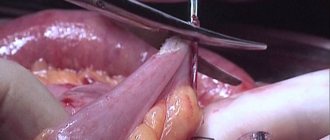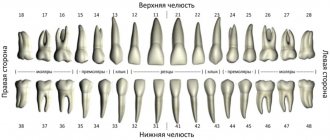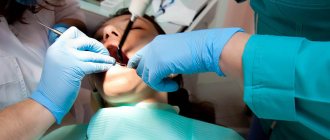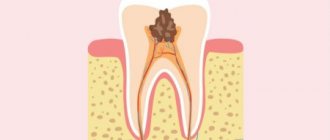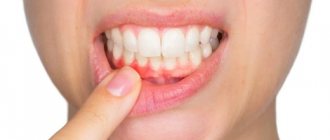Methods of modern dentistry are aimed at preserving the dental unit. Removal is resorted to as a last resort if gentle treatment techniques are ineffective. Resection of the apex of the tooth root (apicoectomy) is a microsurgical intervention for excision of tissue affected by infection with part of the injured tooth root. The operation is performed if the inflammation has taken the form of a cyst or granuloma. The main condition for the success of such a surgical intervention is the timeliness of the patient’s visit to the dentist. If the pathological process spreads to most of the root, the tooth will have to be removed.
Indications for surgery
- Poor endodontic treatment leading to inflammation of the root apex;
- the presence of a cyst, granuloma or other neoplasm, no more than 1 cm in diameter;
- perforation of the root walls during filling;
- pin or stump inlay in the dental canal;
- obstruction of the dental canal due to a congenital developmental defect;
- a crown or bridge placed on a tooth.
Alternative options
- Cleaning teeth using ultrasound . Tartar is destroyed, the integrity of the unit is preserved.
- Drug treatment using antiseptics. The best option is Chlorhexidine in the form of rinses or compresses.
- A course of antibiotics . Allows you to quickly relieve the inflammatory process and alleviate the human condition.
Conservative treatment is not always effective. If characteristic symptoms reappear or the situation worsens, gingivectomy becomes mandatory.
When surgery is not performed
Like any other surgical intervention, apicoectomy has limitations and contraindications. These include:
- Mobility of teeth II-IV degrees;
- destruction of the crown part of the tooth (more than 50%);
- the presence of cracks in the affected root;
- severe curvature of the root canal (impossible to fill);
- crowding of teeth, which does not allow identifying the affected root;
- acute infectious, viral disease;
- severe bleeding disorders;
- decompensated diabetes mellitus;
- severe immunodeficiency;
- oncology in the active stage.
Some of the limitations to root resection are the indication for removal of the affected unit. The second part refers to general contraindications to any surgical intervention. The risk of surgery for the patient is assessed individually.
The specialists at the Ilatan Clinic make every effort to save the dental unit, if possible. But if there are direct indications for removal, for example, extensive damage to dental tissue, the doctor will not suggest apicoectomy.
Therapeutic treatment of cyst/granuloma
Do not be afraid to go to the doctor if you suspect that you fall under the described symptoms of a cyst. Firstly, only x-rays can accurately show whether this is actually the case; secondly, the sooner you see a dentist, the higher the chances that you can do without surgery. Extreme measures are resorted to only when therapeutic treatment has not brought the desired result, or the source of inflammation is in an advanced stage.
However, there is no guarantee that the treatment will have a positive outcome and that surgery will not be necessary. In addition, this process is long and has many stages. To reduce and resolve a cyst or granuloma, the source of infection must be neutralized. At this stage, the doctor works with the root canals: if they have not been sealed, he removes the pulp and carries out treatment; if fillings have been installed, he removes and rinses the canal with an antiseptic.
After this, the doctor installs a temporary medicated filling paste based on calcium hydroxide for several months. To determine the effectiveness of therapy, it is necessary to take another x-ray. In case of successful treatment and reduction of the source of inflammation, the patient will receive a permanent filling.
Best materials of the month
- Coronaviruses: SARS-CoV-2 (COVID-19)
- Antibiotics for the prevention and treatment of COVID-19: how effective are they?
- The most common "office" diseases
- Does vodka kill coronavirus?
- How to stay alive on our roads?
Resection stages
- Formation of access
- the dentist cuts through the gum, exposing the jaw bone. Forms a small hole in the bone tissue (in the projection of the root apex), gaining access to the pathological focus. Often, the bone tissue has dissolved in the projection of the cyst; there is no need to cut out a hole. - Excision of tissues and correction of the apex
- the doctor removes the source of inflammation along with the dead apex of the root, cutting it off perpendicular to the upper dental axis (to the level filled with the filling mass). The empty space is filled with osteoplastic material (bone volume is restored faster). - Suturing
- suturing the wound area is sometimes performed with the installation of drainage for the outflow of ichor. Drainage is installed between the seams and is removed after 1-2 days.
Root resection takes 40-60 minutes, depending on the location of the tooth. It is easier to intervene on canines and incisors than on multi-rooted units.
How is the apex resection procedure performed at the Bionic Dentis dental clinic?
This operation may require 30-60 minutes.
The fact is that the duration largely depends on the location of the affected area. For example, when performing treatment in the area of the front teeth, less time is required and the entire process is much easier. When foci of inflammation affect the back teeth, surgical intervention may be delayed due to difficult access.
It is important how many roots are affected by the inflammatory process. If it is one root, the operation will be shorter than three roots.
In any case, local anesthesia is performed before the procedure. We use only the German painkiller Ultracain DS Forte (made in Germany), which allows us to perform the operation without discomfort and pain.
When tooth root resection is planned on unfilled canals, they are first filled. If it is possible to re-treat the canals for at least 2/3 of the root length, they are re-treated.
To fill canals, the Bionic Dentis clinic uses a special technique - 3D canal filling.
Here's what it looks like:
- The canals are expanded and infected tissue is removed from them mechanically using a nickel-titanium M2 instrument. For this purpose, a computerized root canal system from the German company WDV is used.
- After mechanical cleaning, the channels are sterilized with a medicinal preparation, a sodium hypochlorite solution activated by ultrasound. We use the SIEMENS SIROSONIC ultrasound system. Penetrating into the wall of the canal, the disinfectant kills microbes and opens microscopic tubules, clearing them of infection.
- After disinfection, the canal is dried.
- A small amount of epoxy resin, created for use in dentistry, is injected into a dry and clean canal.
- A gutta-percha pin is inserted into the canal and melted under pressure. Melting, gutta-percha fills all the pores in the canal and micro-branches.
- Next, the channel is filled with molten gutta-percha under pressure from an injector.
The use of this technique is standard in Europe. We also follow this method.
Recovery period
The entire operation lasts about an hour, the recovery period takes up to six months or more, depending on how quickly the bone tissue regenerates. In the first 1-2 days after the surgical procedure, the patient is bothered by moderate pain, swelling, and redness of the gums. After 3-4 days, the unpleasant symptoms decrease and the condition improves. To ensure that the postoperative period passes quickly and without problems, the doctor will give the necessary recommendations for care, prescribe painkillers, as well as a short course of antibiotic therapy.
Wound healing time
The oral mucosa takes approximately 2 weeks to heal. After this period, all symptoms of surgical intervention disappear, and chewing loads do not cause pain. Complete healing of bone tissue requires more time - from 6 to 12 months. During this period, the hole in the bone heals. To monitor this process, radiography should be performed regularly. This diagnostic procedure is prescribed a few days after resection and 6-7 months later.
Care after tooth resection
- Do not chew on the operated side.
- Until the wound heals, avoid irritating, solid foods (food should be warm and soft).
- Do not use a hard toothbrush, aggressive pastes, or mouthwash.
- Take antibiotics prescribed by your doctor to prevent infection.
- Rinse your mouth after eating with an antiseptic solution.
- For the first week after surgery, limit physical activity to moderate, and exclude extreme, contact sports.
- Do not visit the bathhouse, swimming pool, sauna until the wound is completely healed.
- Avoid eating too hard foods until the bone is completely restored (at least 3 months).
- Visit your surgeon regularly to evaluate the results of the operation.
Possible complications
Root resection is a micro-operation, the purpose of which is to preserve the full functionality of the affected tooth. Usually, the risk of complications is minimal, but they cannot be completely excluded. Sometimes the following complications are possible:
- Bleeding due to injury to nearby vessels;
- infection of a postoperative wound;
- recurrence of cysts, granulomas (if all affected tissues were not removed);
- perforation of the maxillary sinus, nasal passage;
- damage to the nerve passing along the alveolar ridge;
Sometimes complications are caused by structural features of the jaw, for example, the proximity of the roots to the maxillary sinus. Complications caused by non-compliance with medical recommendations include swelling and tissue inflammation. Ignoring advice on limiting physical activity is fraught with the development of bleeding, and failure to maintain hygiene can lead to wound infection.
Cost of tooth root resection
The price of root resection is determined depending on the volume of surgical intervention, the cost of consumables, and anesthesia. The result of the procedure fully justifies the money spent. After all, it is cheaper than removal with further implantation and prosthetics. The doctor will tell you exactly how much tooth resection costs after examination and diagnosis.
Laser cyst removal
Science does not stand still, and now there are methods for eliminating an infected sac without unpleasant incisions and long-term treatment. Laser tumor removal has a number of advantages. So, if there is no need to remove nerves, the procedure takes place without painkillers, as it is completely painless. In addition, the laser has an antiseptic and regenerating effect, no bleeding and minimizing complications. Most often, the doctor can close the root canal with a filling immediately after the manipulation.
This procedure involves opening the canals, for which the filling is removed from the tooth, after which a laser is inserted there. The beam is directed at the cyst and destroys all microorganisms. Naturally, such a procedure will cost the patient more. It is also worth considering that if the formation continues to increase after the procedure, you will still have to resort to cystectomy with resection of the apex of the tooth root.
More fresh and relevant information about health on our Telegram channel. Subscribe: https://t.me/foodandhealthru
We will be grateful if you use the buttons:
